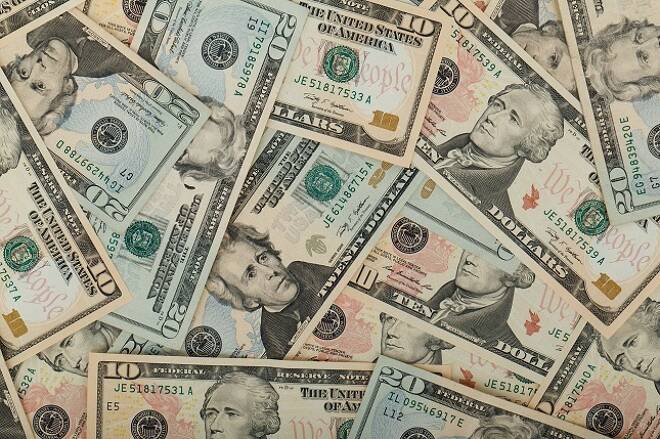Advertisement
Advertisement
U.S. Dollar Boosted by Fed, Solid Economic Data, Weaker Euro
By:
The U.S. Federal Reserve increased the target for the bank’s benchmark by 0.25%, to a range of 2%-2.25%. FOMC members led by Chairman Jerome Powell said the economy is strong enough that aggressive stimulus is no longer necessary. This confidence was shown by the Fed ending its description of its policy as “accommodative”. The divergence between the monetary policies of the hawkish U.S. Federal Reserve and the dovish Bank of Japan helped drive the Dollar/Yen to its highest level since December 21. The Reserve Bank of New Zealand (RBNZ) kept its official cash rate at a record low of 1.75 percent.
The U.S. Dollar closed higher last week, helped by expectations of rising interest rates, political turmoil in the Euro Zone and better-than-expected U.S. economic data.
For the week, December U.S. Dollar Index futures settled at 94.737, up 0.939 or +1.00
U.S. Federal Reserve Raised Rates Again
On September 26, the U.S. Federal Reserve increased the target for the bank’s benchmark by 0.25%, to a range of 2%-2.25%. A majority of Federal Open Market Committee members also said they expect another rise before the end of the year. This was also the bank’s eighth rate hike since 2015, continuing its policy of gradual rate hikes.
FOMC members led by Chairman Jerome Powell said the economy is strong enough that aggressive stimulus is no longer necessary. This confidence was shown by the Fed ending its description of its policy as “accommodative”.
Powell also said the rate hike reflected the Fed’s confidence in the U.S. economy, describing it as a “particularly bright moment”. Powell also warned that a permanent shift to a “more protectionist world” would hurt the U.S. and global economies, but added that for now, he expects the overall economic impact to remain relatively modest. “We don’t see it in the numbers,” he said at a press conference in Washington after the meeting.
Fed Predictions
Fed officials now expect the U.S. economy to grow by 3.1% this year, faster than the 2.8% forecast in March, according to the projections released after the meeting. Their predictions for inflation remained unchanged at around 2%.
The FOMC forecasts showed Fed officials expect about three rate hikes in 2019 and one more in 2020, which would lift the central bank’s important Fed funds rate to about 3.4% that year.
Euro
Helping the U.S. Dollar climb to a two-week high against a basket of currencies was a weaker Euro. The single-currency was pressured nearly all week, settling at 1.1604, down 0.0146 or -1.25%. Concerns about the Italian budget weighed on the Euro.
The EUR/USD fell below $1.16 for the first time in two weeks after Italy’s government agreed on a budget seen by some investors as defying Brussels. Political wrangling over the budget in heavily indebted Italy put a lid on the Euro’s recent rally. Earlier in the week, the Euro spiked higher to 1.1816 after ECB President Draghi spoke of improving inflation figures. However, he killed that rally when he said the news should have no effect on the central bank’s plans to start raising rates after the summer of 2019.
Japanese Yen
The divergence between the monetary policies of the hawkish U.S. Federal Reserve and the dovish Bank of Japan helped drive the Dollar/Yen to its highest level since December 21. The widely expected Fed rate hike last week also widened the spread between U.S. Government bond yields and Japanese Government bond yields, making the dollar a more attractive investment.
For the week, the USD/JPY settled at 113.685, up 1.137 or +1.01%.
In other news, it was revealed in the Bank of Japan summary of opinions that policymakers debated in September the potential of making further tweaks to their massive stimulus program with one member seeing room to make monetary policy more flexible. Another BOJ policymaker called on the need to deepen debate within the nine-member board on the time frame for maintaining the central bank’s ultra-loose policy, the summary showed.
Australian and New Zealand Dollars
The Australian and New Zealand Dollars were pressured all week by rising U.S. interest rates, solid U.S. economic data and lower demand for risky assets. With the Fed raising rates for a third time this year and signaling more to come, the spread between U.S. interest rates and Australian and New Zealand interest rates continued widen, making the U.S. Dollar a more attractive investment.
For the week, the AUD/USD settled at .7217, down 0.0071 or -0.97% and the NZD/USD closed at .6619, down 0.0061 or -0.91%.
Additionally, Final US. GDP rose 4.2%. Core Durable Goods Orders came in at 0.1%. Durable Goods Orders rose 4.5%. The Core PCE Price Index was flat, but Personal Spending rose 0.3%. The Conference Board’s Consumer Confidence hit an 18-year high at 138.4. University of Michigan’s Consumer Sentiment, however, came in slightly below expectations at 100.1.
In other news, the Reserve Bank of New Zealand (RBNZ) kept its official cash rate at a record low of 1.75 percent. RBNZ Governor Adrian Orr said while there were welcome early signs inflation was rising, downside risks to growth remained, particularly “trade tensions” between some major global economies.
About the Author
James Hyerczykauthor
James Hyerczyk is a U.S. based seasoned technical analyst and educator with over 40 years of experience in market analysis and trading, specializing in chart patterns and price movement. He is the author of two books on technical analysis and has a background in both futures and stock markets.
Advertisement
